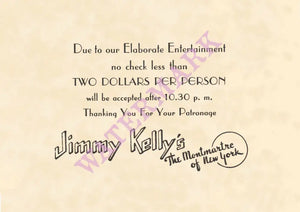Jimmy Kelly's, New York 1930s
Free Shipping In The US
Giovannni Di Salvio was born in a tenement on New York’s Lower East side to a poverty-stricken Italian immigrant family. He sold newspapers on the street as a child and at 14, he turned to professional fighting, changing his name to Jimmy Kelly to fit in with the Irish-controlled boxing world of turn-of-the-century New York.
When that career failed, he got a job at the Pelham Café in Chinatown in 1906 alongside the club’s singing waiter Irving Berlin. Kelly’s job was to control the crowds and pitch pennies at the man who would eventually become one of the greatest songwriters in American history in the hope that customers would follow suit.
Kelly turned to politics and became a political organizer for Tammany Hall, a Democratic party political machine known for helping the poor but also for corruption,
He opened Jimmy Kelly’s the Montmartre of New York in 1921 and it was patronized by both gangsters and respectable society figures. The Blue Ribbon 100-minute floor show featured dancers and a big band, with the New York Times noting that Mr Kelly’s dancing girls and boys “stamp, tap, croon, harmonize and contortion-dance their way without pausing for breath.”
Kelly’s wide circle of friends included Joe di Maggio, Walter Winchell and some of Al Capone’s henchmen. A noted bon viveur, he played host at the restaurant to Britain’s Duke of Windsor (then Prince of Wales) and the Astors and Vanderbilts.
A gambler, he bet on horses, fights, craps, hockey games and baseball but remained a wealthy man. He never forgot his humble roots and paid the rents of many families in Greenwich Village and distributed food baskets at Christmas. For these charitable efforts, he was unofficially called The Mayor of Greenwich Village. He died in the 1950s.
Courtesy Private Collection.
Gallery quality Giclée print on natural white, matte, 100% cotton rag, acid and lignin free archival paper using Epson K3 archival inks. Custom printed with border for matting and framing.
All printed in USA.



